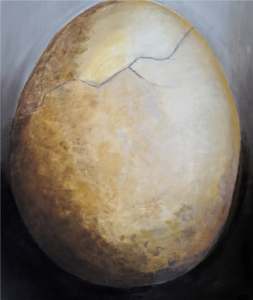La Promesse by André Goffinet
Since the first rumblings about a possible lab leak in Wuhan, my position has been that it is as acceptable, and indeed as inevitable, for a non-scientist to be concerned about gain-of-function research of concern (GOFROC) as they are about climate change and nuclear conflict. But outsiders who choose to involve themselves in the current debates about GOFROC, lay themselves open to aggression and ridicule, as even a casual scroll through Zoonati versus Biosafety Twitter will show. Who are you, runs the argument, to hold an opinion? You wouldn’t know a furin cleavage site from a hole in the ground. If you’re unlucky, names will be called and accounts quickly blocked. Margaret Atwood’s Maddaddam trilogy illustrates this mindset well: Jimmy/Snowman, the arts-and-humanities guy who ends up shilling for genetics genius Crake, is known as Thickney and made all too aware of his humble status. Yet it is Jimmy who survives, half-insane and sleeping in a tree, among the ruins of the world that Crake’s last experiment has largely destroyed.
But rather than taking a defensive position – “my stake in decisions about the future of GOFROC should be as big as yours” – it is possible to ask, what has GOFROC to do with narratology?
It can be argued that GOFROC is a matter with which arts-and-humanities people should concern themselves. Rather than taking epistemological trespassing to a new low, literary critics are simply doing their job by pointing out the disquieting parallels between GOFROC and the representation of other existential threats to humankind, most evidently nuclear conflict, and climate change and its attendant extreme weather events, but also terrorism, financial meltdown, and so on. After all, critical approaches to artistic discourse have always allowed for reading the aesthetic object both for its autotelic qualities and its commentary on reality; furthermore, these two qualities cannot be separated.
In his 1984 essay “No Apocalypse, Not Now”, Derrida famously argued that nuclear war is “fabulously textual”, that is, inherently literary. He pointed to nuclear conflict both as an always-anticipated but never-realised signified, and as the means of the total destruction of the “archive”, the record of the human habitation of Planet Earth. As a theoretician of signification, Derrida was exaggerating to make a point: the absolutist position he presents assumes total nuclear war without factoring in local nuclear conflict. But Derrida, in true French-theoretical style, is concerned with posing a universalizing and hyperbolic hypothesis of meaning and representation. The literary novel, conversely, takes a different stance on the relationship between language and reality, in many cases not only by modelling future realities but also by sufficiently anchoring them in the public consciousness to ensure they do not come to pass. During the Cold War, the films When the Wind Blows (Jimmy Murakami, 1986, an adaptation of Raymond Briggs’ 1982 graphic novel) and Threads (Mick Jackson, 1984), both of which lay bare the realities of nuclear war, were shown repeatedly in war offices on both sides of the iron curtain.
But did Derrida, Murukami, Briggs or Jackson have detailed, specialist knowledge of the science behind the development of the nuclear bomb, or of the possibilities for future adaptations of these weapons? – Not as far as I know. And yet the point they were making was for the benefit of all humanity, because, to put it bluntly, it is not only the physicists who stand to get nuked, just as with regard to GOFROC, it’s not only the virologists and their loved ones who get sick and die if and when a pandemic-potential pathogen leaks from a lab. We all, to return to Atwood, stand to inherit a wasteland.
Historically, examples of popular protest from the scientifically ignorant abound: CND, the Campaign for Nuclear Disarmament, was mostly made up of members of the public who made no pretense of specialist knowledge; Greenham Common in England was occupied for years by ordinary women who just wanted the bombs gone to ensure the safety of their children and of future generations.
But it is not simply that the public should be allowed to have a say on questions that affect the very future of humankind: my point is that the arts have had a great deal to say about the execution of existential threats to humanity. Margaret Atwood makes this point her trilogy: by despising anyone who is not a pure scientist and marginalizing the “word-people” – arts and humanities graduates – Crake greatly impoverishes his future project for the replacement of humanity. Following Crake’s death – he gets what’s coming to him shortly before the near-future chronotope of the novel begins – the post-human, artificially-created “Crakers” demonstrate a clear need for Jimmy/Snowman’s stock of literary knowledge, which he is able to adapt into daily instalments of a neo-myth to explain these newly-created beings to themselves.
The literary novel, in recent times, has been acknowledged as a space in which certain debates can be had, by virtue of the multiple and nuanced positions which a work of fiction can contain, and certain futures modelled. This has become especially important in clifi, climate-change fiction (a genre with slippery boundaries, but, for the sake of argument, one in which the climate emergency and its impact on humankind is foregrounded). Critics such as Adam Trexler and Antonia Mehnert argue that literature can raise ethical, cultural and political questions about the impacts of climate change, engaging in what Ursula Heise terms a “poetics of responsibility”.
Writing twenty years ago, Frederick Buell argued that environmental crisis appears in a complex way not only in the construction of a character’s thoughts and actions but also in ways that are inherent to the narrative structure and style for the novel, so much so that it is completely internalized as a part of the context in which we now dwell. In my recent book, The Noah Myth in Twenty-First-Century Climate Novels: Rewritings from a Drowning World (Boydell and Brewer), I built on this contention to develop the term “Anthropocene Anxiety” to denote the omnipresence of the consciousness of crisis in 21st-century novels, both those which overtly treat climate change and related crises, and those which do not appear to do so. The term Anthropocene Anxiety is intended as an extension of the idea of the need to acknowledge climate change, not a denial of it: taken to its logical conclusion, this notion suggests that all fiction is about climate change – even fiction that does not mention it at all proceeds by the denial, or denegation, of an essential part of the human background. In other words, any contemporary text can be read to some extent as an acknowledgement of, an engagement with, or a denial of climate change. But beyond this, I argue that notwithstanding the omnipresence of climate change in, or as background to, the contemporary novel, there is not necessarily a hierarchy of fears headed by climate change: other factors may be equally prevalent.
While the novels I discuss in my book are generally regarded as a subset of 21st-century flood fictions, now a recognized genre in clifi, climate change is far from being the only crisis evoked. It is striking that in these novels, humanity is faced with a range of existential challenges which have already marked, or are about to mark, the end of human civilization as we know it. I argue that these novels can be read more profitably as novels of multiple crises. These major crises align with other threats, such as terrorism, financial meltdown, scarcity of food and resources and so on, and combine to create a state of emergency which, as Joseph Masco puts it, is not the exception but the rule.
Naturally enough, among these threats are pandemics, both zoonotic and lab-generated. The premise of Margaret Atwood’s post-apocalyptic Maddaddam trilogy (2003-2014) is that humanity has been largely wiped out by a lab-made pathogen; Clare Morrall’s When the Floods Came (2016) takes place in a largely empty Britain following a pandemic which has caused widespread infertility; pandemics are among the fears of the tragi-comic Mitchell Zukor in Nathaniel Rich’s Odds Against Tomorrow (2013), and Maggie Gee’s The Flood (2004) ends with flood sickness spreading through the cartoon version of London which is the backdrop of the novel.
Pandemics, then, have been seen as a gathering threat in the last couple of decades, but have been pushed into the background with the emphasis on the reception of the climate-based “message” of a certain group of novels. Yet pandemics, and the threats posed by GOFROC in particular, are undoubtedly part of what Cynthia Deitering terms the “toxic riskscape” in which humanity has existed since the 1980s, or part of what Lifton termed in 2017 our “malignant normality”. Robert Jay Lifton has termed the threats posed by nuclear conflict and climate change “apocalyptic twins” (2017). Arguably GOFROC, which has a similar potential to wipe out human civilization, should be added in to make triplets.
Yet so far, the literary establishment does not seem as keen to embrace “pan-fi” in response to Covid-19 as it was to embrace “clifi” as a response to climate change. The discourse around this probable lab-leak in Wuhan, and the potentiality for future lab leaks, seems to have become toxic in a number of ways which impact and limit the potential for public debate. Michael Balter, a veteran journalist himself, has argued that the anxiety of journalists to refute climate-change denialism warped their response to Covid, that they have been far too unquestioning of the official story, far too eager to subscribe to the political provenance of a narrative at the expense of any proper fact-checking. One particularly unhelpful circumstance was that former President Trump backed the lab-leak: hence, zoonosis good, lab-leak bad (and that choice of language reflects the simplistic thinking that has too often dominated the debate so far). This reticence to discuss biosafety and to admit its possible impacts on the future of humanity is inhibiting, and that inhibition self-replicates. So far the lab leak seems to have joined Brexit and the reelection of Donald Trump as a subject on which only one opinion is permissible to right-thinking people, and academics are not anxious to risk their reputations by holding a position which is wide open to misinterpretation.
How the pandemic thread in the literary novel itself, as opposed to the academic establishment, remains to be seen: in spite of the publication of the odd “lockdown novel” or short story (see Elizabeth Strout’s Lucy by the Sea, 2021, Jonathan Coe’s, Bournville, 2022, or Margaret Atwood’s “Bad Teeth”, 2023) it will probably take years for “Covid-19 literature” to become a recognized entity. Elizabeth Outka shows that the Spanish Flu pandemic that followed the First World War was largely evident in the gaps and silences of modernist literature; Daniel Cordle argues that a preoccupation with nuclear conflict is often only evident in transient “flashes” in texts. It might take a generation or more than one for the literary novelists and critics to develop a corpus of “GOFROC-lit”. From the arts-and-humanities perspective, this is interesting: in these days of increasing competition for grant money and hires, new material and innovative approaches are highly prized. But to return to the issue of the sidelining of “word people” in the public debates about biosafety and the inherent dangers for humanity of insufficiently-regulated GOFROC, my argument is not only that readers and critics of novels which testify to Anthropocene Anxiety hold in their heads visions of humanity devastated by scientific “progress” at the expense of ethics and are therefore well placed to discuss rather than deny future dangers. It is also that anyone, in any discipline or none, should be allowed, and encouraged, to hold a position about the dangers posed to humankind by infringements of biosafety.


